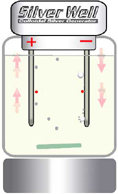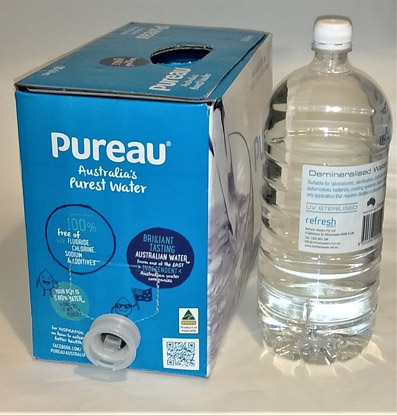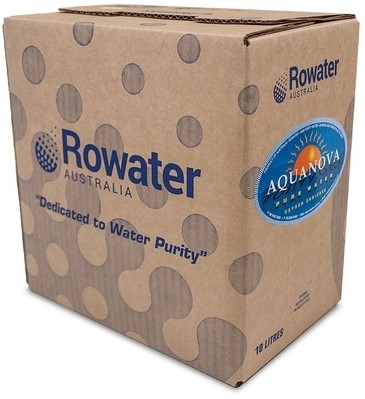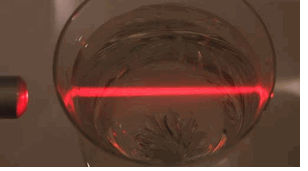The following comments should not be taken as my recommendation that you drink the CS made with any of these brands. I'm simply advising which brands make good CS. What you do with that CS is entirely your own decision.
ANY WATER THAT GOES CLOUDY WHITE SOON AFTER THE POWER IS APPLIED IS NO GOOD!
Water suitable for making colloidal silver should measure below about 2 ppm on a TDS meter or below about 4.5 uS on an EC meter.
(As a comparison, your capital city mains tap water could be up to 400 ppm on a TDS meter)
IN AUSTRALIA Nobles PUREAU water is probably the most widely available pure water, and is good value in 10 litre cardboard casks. It's purified using reverse osmosis. Pureau water is available in the drinking water department of most major supermarkets. About $9 for 10 litres.
REFRESH distilled water is also widely available in the drinking water dept of supermarkets in most states and is excellent for making colloidal silver. (www.refreshwater.com.au). They also make a very good quality demineralised water that is suitable for making colloidal silver. You may find that in the laundry products dept.
GLENDALE distilled water is available at many K-marts. It's also available in bulk in NSW direct from the distiller.
Demineralised or deionised water is more common and sometimes a bit cheaper than steam distilled water. I have usually found it to be very good for making Colloidal Silver. The quality of the water can vary but most of the brands from supermarkets including the generic brands (Black and Gold etc) seem to be good. I wouldn't use the brands from auto shops. Demineralised water is usually found in the 'ironing aids' aisle. It may be labelled 'Not For Drinking'. (Price is usually under $2 for 2 litres).
BLACK AND GOLD distilled water and Coles SMART BUY demineralised water also seems to be quite good.
DIGGERS brand demineralised water can be good but the quality seems to vary greatly so generally it is not recommended.
SUPERIOR brand demineralised water bottled in Qld CANNOT be recommended.
Western Australian customers tell me that DAVID GREY'S deionised water water is widely available and suitable for making colloidal silver although the quality seems to vary. A better option is to look for 'REFRESH' distilled drinking water in supermarkets.
|
|
|
South Australian customers can buy ROWATER Aquanova ultra high purity drinking water direct from the factory or have it home delivered. In 10 litre casks, it's ideal for making colloidal silver and is quite cheap at around $1 per litre. Delivery in the metro area is free. http://rowater.com.au/
|
NEW ZEALAND customers tell me that 'PURE DEW' ultra pure water is ideal. It's available in 1 to 10 litre containers from Woolworths, The Warehouse, Pak 'n' Save, and New World.
OTHER SOURCES OF PURE WATER....
RAIN WATER. If you can catch it straight out of the sky in a perfectly clean container then its usually OK, but after its run across your roof, along your gutters, and into your tank then the quality is borderline and probably not suitable for making colloidal silver.
WATER FROM HOME FILTER SYSTEMS. Tap attachments, simple under-sink cartridge filters, and counter-top pottery filters are totally unsuitable for making water for CS as they do not remove dissolved salts at all!
The only home purification system (other than a steam distiller) that can produce water suitable for making CS is a high grade (usually expensive), well maintained, reverse osmosis unit WITHOUT any additional post-filtration mineralisers.
D.I.Y. WATER DISTILLERS. Home distillers are becoming more affordable, and for some people they are a worthwhile alternative to buying water. I regularly use a 4 litre bench top electric distiller with a stainless steel tank and it produces quite good water. (About $120 on Ebay). However, if you are distilling water for CS there are couple of things to remember. Most importantly DO NOT use the charcoal or coconut 'post-filter' satchets. These filters put impurities back into the water that can spoil the quality of your CS batch. Also you should scrub the tank with a soap-free scourer and rinse it with clean water after every 2 or 3 batches. Also, if you can remember to do it, its a very good idea to discard the first few centimetres of water from the distiller, and, later on, turn the distiller off before it fully empties. This will get rid of any low boiling point imputrities that are in the water, and prevent the dregs from getting baked onto the bottom of your distiller.
What's wrong with using tap water?
Why can't I use tap water? Won't it just make a mixture of colloidal silver and tap water? No, because as the silver ions are released from the electrodes they will immediately combine with salts, minerals, and other impurites in the tap water to form silver nitrates, chlorides, and other compounds. The end result is that you you won't get nicely isolated 'bio-available' colloidal silver ions and particles. This means that you are either wasting your time producing inneffective water, or possibly producing a cocktail that your body won't appreciate. To make the safest and most beneficial CS you must start with pure distilled or demineralised water. And never add anything like salt or baking soda to the water to speed up the brew.
NOTE: Many travellers briefly use a colloidal silver generator to help sterilise local drinking water. This is probably a good idea for SHORT TERM usage, but after sterilising the water, there may not be enough free silver ions remaining in the water to be of significant further health benefit IN the body. CS made with impure water should not be consumed on a long term regular basis and a generator used for this purpose should be run for the shortest possible time.
Storing colloidal silver - Glass or plastic bottles?
There's been plenty of debate about whether to store colloidal silver in glass or plastic bottles, but I think most experienced makers now believe that good quality plastic is just as good as good quality glass. Personally I've never had a problem using HDPE plastic (the waxy type of plastic that demineralised water comes in), although some recent research suggests that PET plastic (Coke or mineral water bottles) MAY be marginally better. Demineralised water bottles don't need to be rinsed but Coke bottles should be well rinsed with clean warm tap water and allowed to drip dry. Larger volumes should be stored in a cupboard, out of the light, but its handy to keep a small coloured glass or plastic bottle on the kitchen counter for daily use.
Should I store it in the refrigerator?
Absolutely not. Always store colloidal silver at room temperature. The reason is pretty simple. Colloidal silver is simply water with silver dissolved in it. If you lower the temperature of the water then you reduce the ability of that water to keep the silver in solution. Cooling the water reduces it's 'saturation point', forcing the silver to precipitate out of solution and eventually settle to the bottom of the bottle.
For the same reason you should NOT make colloidal silver with hot water. You are simply artificially and temporarily raising the saturation point of the water. When the water cools the silver will be forced out of solution to create large particles that will eventually settle to the bottom of the jar.
Is colloidal silver light sensitive?
Yes and no. A good quality batch of colloidal silver made with excellent water will often stay completely clear and colorless even in strong light. But batches are rarely perfect (even distilled water is never totally pure) so some degree of light sensitivity is common. Whether or not this makes much difference to the effectiveness of the CS anyway is debatable, but it's probably good practice to store CS out of direct light.
What's this stuff about Ions and Particles?
What most people refer to as colloidal silver is water containing silver ions and silver particles.
Silver ions are silver atoms that have lost an electron. They are positively charged. (They are sometimes incorrectly called 'charged particles or even 'micro-particles' but in fact they are not particles at all). Silver ions, created via the the application of low voltage electricity, will dissolve in water. In good quality CS these ions are dispersed evenly throughout the water. As silver ions are released in the water they raise the electrical conductivity of the water, and consequently can be measured (approximately ) with a PPM or EC meter.
The silver particles or collids on the other hand are exactly what the name implies - microsopic particles (colloids) that may be made up of relatively few, or many thousands of silver atoms. They may be pure silver, or silver oxides, but they are so small they stay permanently suspended within the water and do not settle to the bottom. Its important to note that these particles are not actually made 'by' the generator. They are created in the water as the ions combine. Current control and Stirring, as featured in the Silverwell system, helps to keep these particles small. These particles do not raise the conductivity of the water so they cannot be measured with a PPM or EC meter but you canb 'observe' then with a laser. Good quality CS generators are designed to make (1) a high concentration of ions that stay in solution and (2) the smallest possible particles because these are believed to be more 'bio-available'. (i.e. more easily absorbed by the body.) It is much better to have lots of very small particles than to have just a few relatively big ones. LVDC generators like the Silver Well make colloidal silver in which the total silver content is about 85% Ionic and 15% particles.
A note on particle and ion sizes.
A silver ion is a single silver atom that has lost an electron. All silver ions are the same size now matter how they are made. You can't get a silver component smaller than an ion. An ion is not a particle, but some producers will deliberately confuse the two in order to claim they produce extremely small particles or so-called 'microparticles'. Ions and particles are two completely different and beneficial forms of silver and as such need to be considered independently.
For more information about ions and particles theres a lengthy discussion at the bottom of this page.
What works best? Ions or particles?
If you search the internet you will soon find very persuasive sites spporting both sides of the 'Ions Versus Particles' debate. But the truth is that no-one really knows if its the 'oligodynamic' properties* of the ions or particles that are the doing the most good in colloidal silver, although most current research seems to favour the ions. It's also possible that ions and particles both achieve the same thing, but in different areas of the body. There are also some theoretical chemical sequences that suggest that ions convert to particles in the blood stream, or alternatively, some particles release ions. What we can be sure of though, is that what most people have been using and praising for the last 20 years is colloidal silver that contains BOTH ions and particles - because that's the sort of colloidal silver that has been most readily available. Good quality, commercially bottled colloidal silver is about 85% ionic and 15% particles - the same as colloidal silver produced in a Silver Well. Statements by some bottlers that their 'new' CS is more effective because it is (supposedly) 100% ionic, or 100% particles, have no such history of everyday usage to support their claims. Quite simply, we dont need to take sides in the ions versus particles debate because the Silver Well gives you both.
*The Oligodynamic property is the ability of small amounts of metals to exert a lethal effect on bacteria. (Greek: Oligos/small. Dynamis/power.) The effectiveness of some metals as germicidals is due to the high affinity of cellular proteins for metallic ions. Bacteria cells die due to the cumulative effects of ions within or in contact with the cell, even if the concentration of ions in the solution is miniscule. Exactly why these ions are lethal to bacteria is not fully known but it may be that they dissable the bacteria's ability to deal with oxygen.
Can't I make my own basic generator?
Yes its easy to make a basic generator and it can be an enjoyable project. But a basic generator makes a pretty basic form of colloidal silver. A simple home made system cannot consistently and easily produce stable, clear, colorless, colloidal silver. In fact, producing anything above 5 ppm with a home made generator can be frustrating. (The same goes for the cheap 'battery in a box' type commercial generators). If you want a clear, stable product, rich in isolated silver ions and small particles you need to build a much more sophisticated generator and have an excellent understanding of the principles of colloidal silver making. You should also have a stirring method of some kind. The high ppm colloidal silver in the wine glass on the 'What is CS' page was made with a Silver Well. It would be very difficult (probably impossible) to make anything like it with a basic home made system.
What does PPM, TDS and PWT mean?
PPM means 'parts per million'. Its a popular way of describing the amount of silver in the water. It really indicates the total combined weight of silver ions and particles in the water - it does not indicate the actual number of particles. (1 PPM is roughly equivalent to a total of one milligram of silver per litre. A milligram is one thousandth of a gram. So a litre of 10 PPM colloidal silver contains 10 milligrams of silver. That's just 10 thousandths of a gram). PPM can only truly be measured by a scientific laboratory using thousands of dollars worth of specialist equipment. No hand-held meter in the world can actually measure PPM, so hand-held PWT and TDS meters are a guide only. They really only measure the electrical conductivity (EC) of the water. (Silver ions make the water more electrically conductive). The EC or PWT (Pure Water Tester) gives that reading in microseimens, the unit of electrical conductivity. The TDS (Total Dissolved Solids) meter also just measures conductivity but then uses an inbuilt conversion factor to give a readout that (when doubled) is accepted as a reasonable approximation of the PPM. Colloidal Silver Generators with current controls (like the Silver Well) also use electrical conductivity to estimate the PPM. (See our Meters and Lasers page for more info).
What PPM do I need?
A PPM of around 10 - 20 has been shown countless times to be safe and effective. Most 'credible' commercial bottlers of Colloidal Silver claim that their product is in this range. (CS labels that claim ppm's significantly higher than this should be treated with suspicion). PPM in this range of 10 to 20 is easily and automatically produced with a Silver Well. The maximum clear PPM possible with an electric colloidal silver generator system is normally around 30 ppm. You can achieve this with a Silver Well if you follow a few special procedures such as using small jars and allowing the batch to stabilize between 're-charges'.
IMPORTANT NOTE: Some brands of Ulta high PPM colloidal silver (in the 100's or 1000's of ppm's) are not made electrically. They may be made chemically or mechanically, and should not be confused with the modern, safe, electrically dissolved colloidal silver that is made with a Silver Well. Makers of these ultra high PPM products use very old research to support their claims of effectiveness.
Should CS be yellow or clear?
It was once considered that pale yellow was the ideal colour for colloidal silver. This was a reasonable statement, but it was also largely a matter of convenience for users of basic generators, as the color change from clear to pale yellow provided a visual indication that it was time to stop. (The color change indicated the electrolytic process had begun to accelerate and create larger, undesirable particles). Today however, current controlled, generators with a stirring system like the Silver Well are designed to only produce small particles and isolated ions, so the CS usually remains perfectly clear even when relatively high PPM colloidal silver is produced. So the short answer is: Yellow is OK, but clear is best.
|





